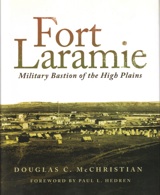Fort Laramie, Military Bastion of the High Plains – Book Review
 Fort Laramie: Military Bastion of the High Plains. Douglas C. McChristian. Arthur H. Clark Co., 2009. Clothbound. 456 pages with illustrations. $45.00.
Fort Laramie: Military Bastion of the High Plains. Douglas C. McChristian. Arthur H. Clark Co., 2009. Clothbound. 456 pages with illustrations. $45.00.
Fort Laramie was also the pioneers’ “point of no return,” the last chance for the faint-hearted to turn back before undergoing the much greater rigors awaiting them.
Since this reviewer’s summer vacations have most often been to Sheridan, Wyoming, our travel route from Missouri to Wyoming invariably follows the old “Emigrant Trail,” the well-worn path that pioneers blazed across the Plains from “The States” to Oregon, Utah and California in the mid-19th century. Generally paralleling the Platte River’s path across Nebraska, the pioneer wagon train route has now evolved into Interstate 80 and its concrete tributaries. In western Nebraska, the Emigrant Trail departs from I-80 to follow the North Platte River as it veers northwestward along present day US Highway 26. Although the last pioneer wagon train has long since passed along this route, the landmarks by which the emigrants measured their westward progress are still there: Chimney Rock; Courthouse Rock; Scotts Bluff; and Fort Laramie. And while the first three of these pioneer landmarks served mainly as convenient milestones or geographic oddities that livened up talk around the campfire, Fort Laramie was a virtual oasis in the wilderness, a frontier outpost at which the travelers could rest or replace trail-weary animals, reorganize, re-fit, stock up on depleted supplies, and catch up on news from “The States” that had filtered into the post through Army channels. Fort Laramie was also the pioneers’ “point of no return,” the last chance for the faint-hearted to turn back before undergoing the much greater rigors awaiting them when the Emigrant Trail crossed the Rockies and the Sierra Nevada mountain ranges. In one season alone, 75,000 emigrants passed through Fort Laramie on the way west. During the height of the great migration (roughly, 1849–70), the post’s military garrison hosted perhaps a quarter of a million pioneers.
{default}Active as a U. S. Army post from 1849 to 1890, Fort Laramie is, arguably, the most important Frontier Army installation in the history of the West. Strategically located for the greater part of its active existence, Fort Laramie indeed performed its role as “the military bastion of the High Plains,” as the subtitle of Douglas C. McChristian’s outstanding new book claims. Its success in this role, ironically, was a key factor in its eventual isolation and, in 1890, its abandonment by the Army – long the focus of interaction with and military operations against Native American tribes (notably the Lakota and Cheyenne) inhabiting Nebraska, Kansas, Colorado, Wyoming, Montana and the Dakotas, Fort Laramie outlived its usefulness when military campaigns and the disappearance of the buffalo herds forced the tribes onto permanent reservations far from the fort. The final death blow, however, was delivered not by Indians but by Eastern railroad magnates when rail line construction bypassed the fort.
Doug McChristian’s Fort Laramie: Military Bastion of the High Plains is a meticulously researched, extensively documented, and wonderfully written account of the fort’s history. Although other books have preceded this one, McChristian’s new book is destined to be acclaimed as Fort Laramie’s definitive history, the standard against which all other books about the fort are measured. McChristian is well suited to write this detailed account, having previously served as the National Park Service’s Field Historian at Fort Laramie, and his perspective in placing the Laramie story within its historical and geographical context is enhanced by his other National Park Service postings at Santa Fe, Fort Davis and the Little Bighorn Battlefield National Monument. In short, McChristian is exactly the right man for the job. He has also honed his considerable skills as a historian and author in his previous books, including Fort Bowie, Arizona: Combat Post of the Southwest, 1858-1894, and the two-volume Uniforms, Arms, and Equipment: The U. S. Army on the Western Frontier, 1880-1892 (all previously reviewed in Armchair General magazine’s Bookshelf department).
Fort Laramie is a “must read” book for anyone interested in the Frontier Army, the Indian Wars, the westward migration, or the real history of the Old West. It is also a great read for today’s travelers whose vacation plans take them along the same route the pioneers took in their journey west – the book provides all the background necessary to make their visit to the “military bastion of the High Plains” a rewarding and meaningful sojourn into the past. We give McChristian’s new book 5 STARS, our highest rating.

